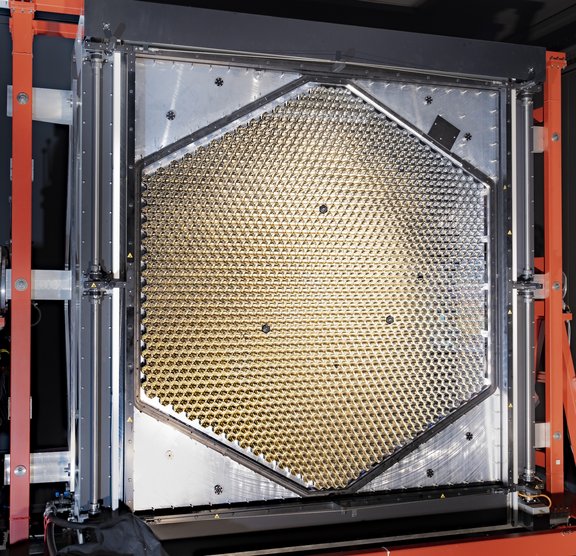FlashCam is one of the most advanced camera systems for ground-based, imaging atmospheric Cherenkov telescopes. Arrays of such telescopes, like the H.E.S.S. experiment or the future observatory CTA, are used to search for astrophysical sources of very high-energy gamma-rays.
Functional key building blocks of the FlashCam design are the photodetector plane, with an area of almost 4 square meters, and a high-performance, fully digital trigger and readout system. The photodetector plane consists of 147 modules, each containing 12 photomultiplier tubes (PMT) with peak quantum efficiencies above 40%. The analogue signals of the PMTs are digitised continuously with a sampling rate of 250 million samples per second at 12-bit resolution. The data stream of the digitised signals is processed in real time by 96 FPGA-based processors, working in parallel. Through digital filter techniques implemented on the FPGAs it is possible to identify coincidences of faint, nanosecond-long light flashes originating from air showers, and to record sequences of the corresponding images with repetition time of 4 nanoseconds. Depending on configuration, such “nano-movies” can be recorded with a duration of up to about 16 microseconds. The image data is then transferred into a high-performance server via an Ethernet-based front-end readout. Using an optimised scheme, more than 3 GByte/s can be transferred without packet loss, resulting in a deadtime-free acquisition of more than 30000 image sequences per second with a duration of about 100 nanoseconds.
After several years of development work, and a 3 year period of testing and optimising a full-size prototype camera, the design of FlashCam is rather mature. An advanced version of the camera design has been installed in the H.E.S.S. experiment in Namibia in October 2019 to improve performance of its CT5 telescope, which is the largest Cherenkov telescope worldwide. In parallel, the team prepares for the production of FlashCam cameras for the medium-sized telescopes of CTA. Ongoing work also comprises the development of operation and analysis software and methods, including the application of machine learning techniques.
The FlashCam project is led by the MPIK group and conducted in close cooperation with the Universities of Erlangen, Tübingen and Innsbruck. Key contributions of the MPIK group are the design concept of the camera and the development of the complete digitization-, trigger- and readout system, and its related firmware and software, as well as the development of simulation and analysis tools.

